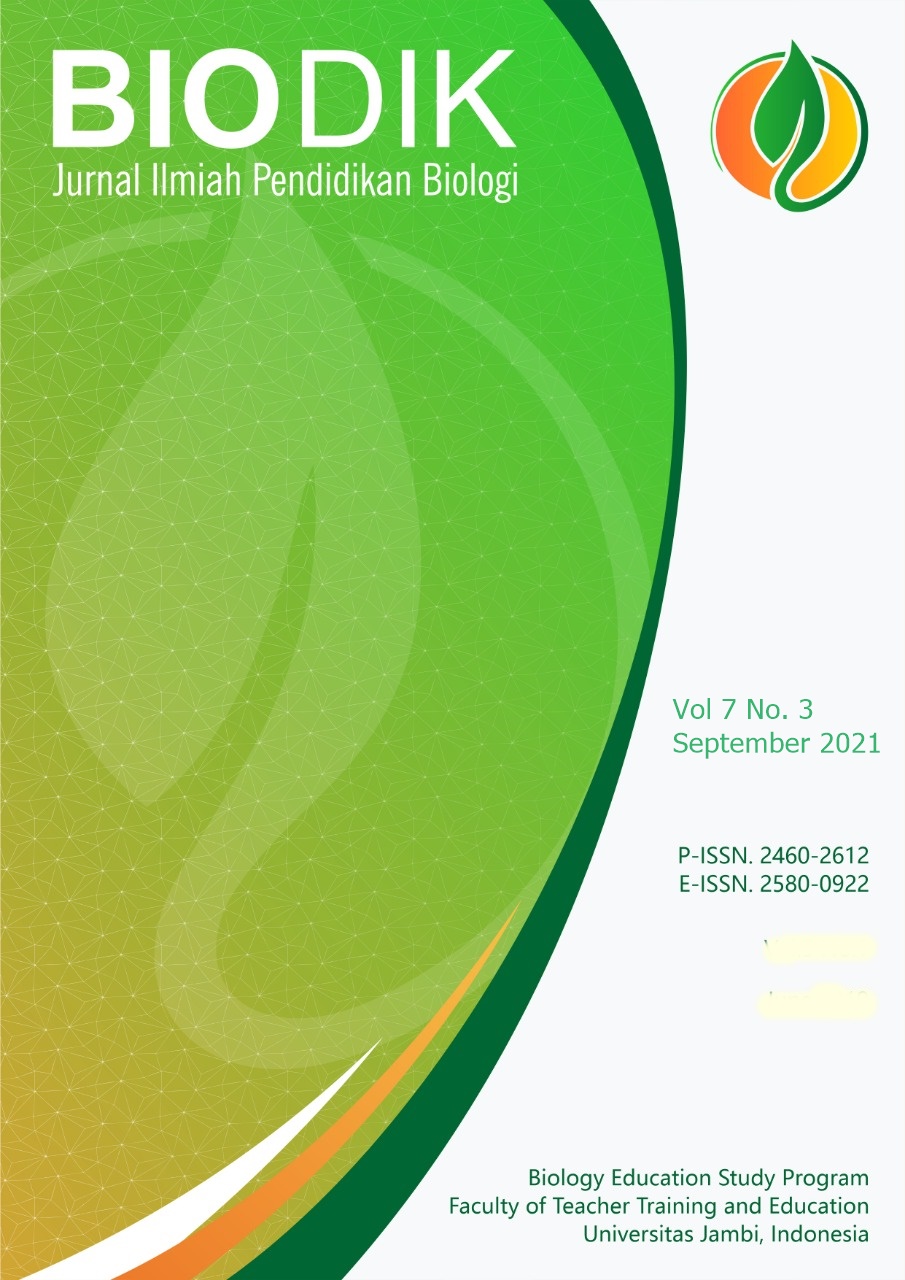Profil Kemampuan Penalaran Ilmiah Siswa SMP Berdasarkan Gaya Belajar
(Profile of Scientific Reasoning Ability of Junior High School Students Based on Learning Style)
DOI:
https://doi.org/10.22437/bio.v7i3.13347Abstract
This study aims to describe the scientific reasoning abilities of junior high school students in science learning based on learning styles at SMPN 15 Sukabumi City. The sample in this study was 35 students of class VII SMPN 15 Sukabumi in the academic year 2020/2021. This research uses qualitative methods through a descriptive approach. The research instruments used were questionnaires and scientific reasoning test instruments Lawson Classroom Test of Scientific Reasoning (LCTSR) which consisted of 12 reasoned multiple choice questions containing 6 indicators of scientific reasoning, namely: proportional reasoning, probabilistic, correlational, conservation, variable control, and hypothetical. deductive. The results showed that the learning style most often used by junior high school students was the visual learning style. This is evidenced by the results of questionnaires that have been distributed, as many as 17 students or 48.58% of the 35 students analyzed tended to use visual learning styles compared to auditory and kinesthetic learning styles. Students with this visual learning style have better scientific reasoning abilities. In addition, overall junior high school students do not yet have the ability to compare two variables of a phenomenon based on a constant ratio, which means junior high school students have scientific reasoning skills on low hypothesis-deductive indicators.
Penelitian ini bertujuan untuk mendeskripsikan kemampuan penalaran ilmiah siswa SMP pada pembelajaran IPA berdasarkan gaya belajar di SMPN 15 Kota Sukabumi. Sampel pada penelitian ini yaitu 35 siswa kelas VII SMPN 15 kota sukabumi tahun ajaran 2020/2021. Penelitian ini menggunakan metode kualitatif melalui pendekatan deskriptif. Instrumen penelitian yang digunakan yaitu angket dan instrumen tes penalaran ilmiah Lawson Classroom Test of Scientific Reasoning (LCTSR) yang terdiri 12 soal pilihan ganda beralasan yang memuat 6 indikator penalaran ilmiah yaitu: penalaran proporsional, probabilistik, korelasional, konservasi, pengontrolan variabel, dan hipotetic-deduktif. Hasil penelitian menunjukkan bahwa gaya belajar yang paling banyak digunakan oleh siswa smp adalah gaya belajar visual. Hal ini dibuktikan dari hasil angket yang telah disebar, sebanyak 17 siswa atau 48,58% dari 35 siswa yang dianalisis cenderung menggunakan gaya belajar visual dibandingkan gaya belajar auditorial maupun kinestetik. Siswa dengan gaya belajar visual ini memiliki kemampuan penalaran ilmiah yang lebih baik. Selain itu, secara keseluruhan siswa smp belum memiliki kemampuan untuk membandingkan dua varibel suatu fenomena berdasarkan rasio konstan yang artinya siswa smp memiliki kemampuan penalaran ilmiah pada indikator hipotesis-deduktif yang rendah.
Downloads
References
Bachtiar, R. W. (2013). PENGEMBANGAN INSTRUMEN PENGUKURAN KEMAMPUAN PENALARAN ILMIAH FISIKA (KAJIAN KEMAMPUAN PENALARAN ILMIAH MAHASISWA PENDIDIKAN FISIKA). 37, 1–7.
Bo, Y. (2019). Evaluation of the Scientific Reasoning Skills of 7th Grade Students in Science Course. 7(6), 1430–1441. https://doi.org/10.13189/ujer.2019.070610
Chania, Y., Haviz, M., & Sasmita, D. (2016). Hubungan Gaya Belajar Dengan Hasil Belajar Siswa Pada Pembelajaran Biologi Kelas X SMAN 2 Sungai Tarab Kabupaten Tanah Datar. 8(1), 77–84.
Daik, A. K. V, Abi, A. M., & Bien, Y. I. (2020). Analisis gaya belajar matematika pada siswa kelas vii smp negeri oebaki. 2(1), 18–24.
Haryono, A. T. (2018). Profil Kemampuan Penalaran Induktif Matematika Mahasiswa Pendidikan Matematika UNIPA Ditinjau Dari Gaya Belajar. 1(2), 127–138.
Mufidah, L.-L. N. (2017). Memahami Gaya Belajar untuk meningkatkan Potensi Anak. In Martabat: Jurnal Perempuan dan Anak (Vol. 1, Issue 2). https://doi.org/10.21274/martabat.2017.1.2.245-260
Ramdhan, B., Susilawati, L., & Ratnasari, J. (2012). Pengaruh Model Pembelajaran Contextual Taeching andLearning (CTL) Terhadap Keterampilan Proses Sains Siswa SMAN 1Cisaat. Jurnal Ilmiah Pendidikan Biologi Dan Sains.
Sutarno, S., & Bengkulu, U. (2017). Profil Penalaran Ilmiah ( Scientific Reasoning ) Mahasiswa Program Studi Pendidikan Fisika Universitas Bengkulu Tahun Akademik Seminar Nasional dan Rapat Tahunan Bidang MIPA 2014 | SEMIRATA. May 2014.
Yuliati, L., Mufti, N., Fisika, P., & Malang, P. N. (2016). PENYELESAIAN MASALAH SINTESIS FISIKA. 1, 1594–1597.
Zhou, S., Han, J., Koenig, K., Raplinger, A., Pi, Y., Li, D., Xiao, H., Fu, Z., & Bao, L. (2016). Assessment of scientific reasoning: The effects of task context, data, and design on student reasoning in control of variables. Thinking Skills and Creativity, 19, 175–187. https://doi.org/10.1016/j.tsc.2015.11.004
Downloads
Published
How to Cite
Issue
Section
License
Copyright (c) 2021 Siti Nurjanah Firdaus, Suhendar, Billyardi Ramdhan

This work is licensed under a Creative Commons Attribution-NonCommercial-ShareAlike 4.0 International License.
Copyright Notice
Authors who publish with Biodik : Jurnal Ilmiah Pendidikan Biologi agree to the following terms:
- For all articles published in Biodik : Jurnal Ilmiah Pendidikan Biologi, copyright is retained by the authors and grant the journal right of first publication with the work simultaneously licensed under a Creative Commons Attribution-ShareAlike 4.0 International Licensethat allows others to share the work with an acknowledgment of the work's authorship and initial publication in this journal.
- Authors are able to enter into separate, additional contractual arrangements for the non-exclusive distribution of the journal's published version of the work (e.g., post it to an institutional repository or publish it in a book), with an acknowledgment of its initial publication in this journal.
- Authors are permitted and encouraged to post their work online (e.g., in institutional repositories or on their website) prior to and during the submission process, as it can lead to productive exchanges, as well as earlier and greater citation of published work (See The Effect of Open Access).

















